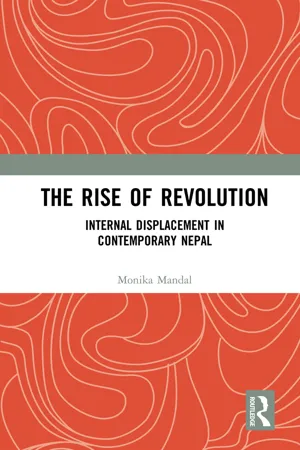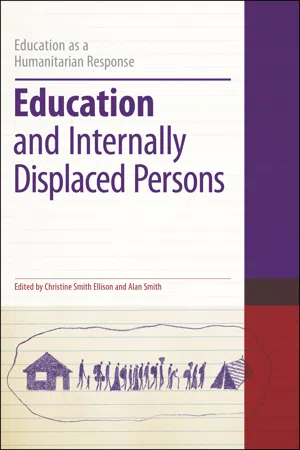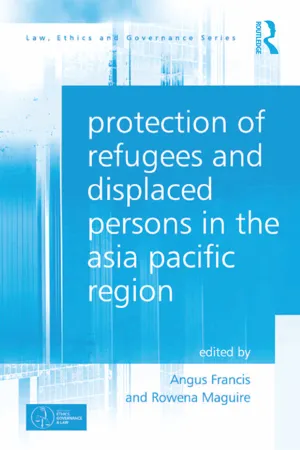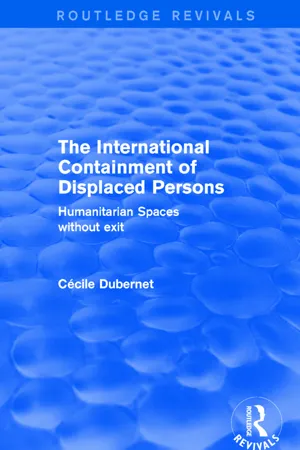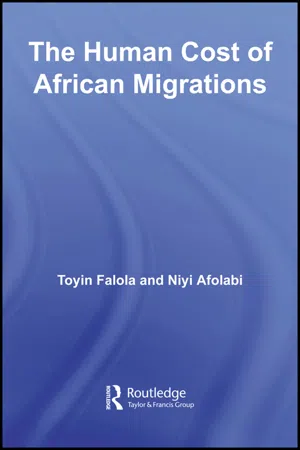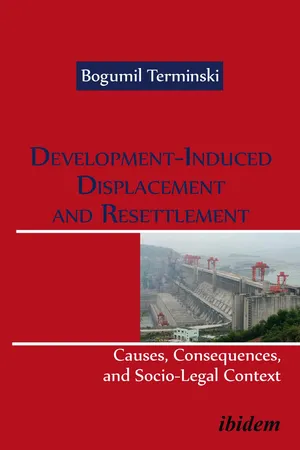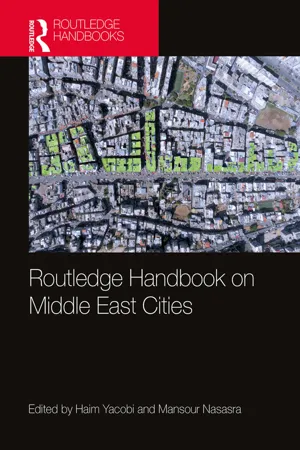Geography
Internally Displaced Persons
Internally Displaced Persons (IDPs) are individuals who have been forced to flee their homes due to conflict, violence, natural disasters, or human rights violations, but have not crossed an international border. They remain within their own country and are often in need of humanitarian assistance and protection. IDPs face challenges in accessing basic services and rebuilding their lives.
Written by Perlego with AI-assistance
Related key terms
11 Key excerpts on "Internally Displaced Persons"
- eBook - ePub
- Patricia Hynes(Author)
- 2021(Publication Date)
- Routledge(Publisher)
3 Who is an ‘internally displaced person’?Introduction
This chapter looks at another form of displacement – within countries of origin – for people who are displaced due to armed conflict, generalized violence, violations of human rights natural or human-made disasters. Unlike refugees, Internally Displaced Persons (IDPs) do not have an international legal definition to confer special legal status. Instead, non-binding guidance is available – the 1998 Guiding Principles on Internal Displacement – and this is discussed later, as is its integration into the 2006 Great Lakes IDP Protocol and the 2009 African Convention on Protection and Assistance for Internally Displaced Persons (commonly referred to as the Kampala Convention).This chapter therefore considers the 50.8 million Internally Displaced Persons (IDPs) in the world as at the end of 2019 who are considered to be a category of concern for UNHCR. Causes of internal displacement, where IDPs are located in the world and global trends are outlined. Thereafter, examples of IDP situations are provided with elaboration of the needs and risks inherent in the experience of being internally displaced. Again, short summaries of the work of key thinkers, maps and key concepts are provided along with case studies and points for discussion.Throughout, readers should be alert to protection of IDPs being primarily about national protection mechanisms. In other words, the domestic legislation of a State should mean that IDPs do not lose any rights because they have been displaced (Kalin, 2014:166). IDPs should enjoy all the relevant guarantees of human rights applicable to the wider population. However, in many cases, IDPs may be discriminated against and treated as second-class citizens in their own country (Ibid.). Readers should bear in mind limitations and challenges inherent in providing protection within a State – a sovereign State – without a legal or institutional base for the international community to provide protection or assistance. A short timeline of selected legislation including IDPs is provided in Figure 3.1 - eBook - ePub
The Rise of Revolution
Internal Displacement in Contemporary Nepal
- Monika Mandal(Author)
- 2017(Publication Date)
- Routledge(Publisher)
CHAPTER 1Guiding Principles on Internal Displacement
INTRODUCTION
Internal displacement is not a new phenomenon, yet it has come to the fore in recent years capturing significant and sustained international attention and concern. However, despite being firmly embedded in the international lexicon, there is no universal or legal definition of an IDP though several definitions have been offered. When the issue of internal displacement emerged onto the international agenda in the early 1990s, no definition of an IDP existed.1The term ‘IDP’ refers only to people uprooted by conflict, violence and persecution, that is people who would be considered refugees if they crossed a border. Global statistics on IDPs generally reinforce this view by counting only those displaced by conflict. Others, however, consider internal displacement concept to be a much broader concept and to encompass the million more persons uprooted by natural disasters and development projects. Confounding matters further is that in common parlance IDPs are often referred to as ‘refugees’, which tends to be a catch phrase to describe all uprooted peoples without regard to whether they have left the country, as the legal definition of ‘refugee’ requires. This tends to blur the distinction between refugees and IDPs. Having a definition for IDPs is absolutely essential for identifying the populations of concern and their particular needs, compiling data, and framing laws and policies designed to protect and assist them. A definition will be instructive in outlining norms of protection in legal terms, in conformity with the principle that subjects of the law must know how to behave in terms of both rights and duties.2 In searching for a definition of IDPs, the issue of protection remains central, and the challenge is to find a precise, but flexible, definition which would cover all those internally displaced and in need of international protection.3 - eBook - ePub
Internal Displacement and Conflict
The Kashmiri Pandits in Comparative Perspective
- Sudha Rajput(Author)
- 2019(Publication Date)
- Routledge(Publisher)
Guiding Principles on Internal Displacement clarify the concept of IDPs as applying topersons or groups that are forced or obliged to leave their homes and who seek shelter within their country, as opposed to the refugees who may be forced or obliged to leave their homes for the same reasons but who cross an internationally recognized border in order to secure shelter.(UNHCR, 2004)The labeling of those who flee or are forced to flee into these two distinct categories has deeper implications, which come to impact not only people’s rights to return and rehabilitation but also their standing in the host communities, thus impacting their everyday lives. The host communities are the new societies where the families come to seek shelter or are directed to do so by the responsible agencies.Among the forces that result in internal displacement are ethnic violence, clashes between the majority and the minority groups, civil wars, political unrest, the actions of oppressive regimes, the rise of militancy, illegal seizure of land, natural disasters, and a nation’s own development projects and agenda.This book addresses what appears to be the most troubling of these forces: namely, the conflict-induced displacement, which accounts for an estimated 38 million of all those living in internal displacement (BBC, 2015). Often rooted in forced evictions by members of one’s own society, such displacement leaves enduring scars of shame, humiliation, and loss of moorings, not only affecting those displaced but also spilling onto a whole new generation born and raised inside the camps, settlements, and compartmentalized communities. Communities displaced by conflicts are never fully accepted either, in host communities or on return to their own ancestral homes. Paradoxically, these groups remain tied to the forces that displaced them in the first place. Entrapped in political and community parameters of government-designated housing or remaining in the shadows of their host communities, these families endure an upsetting process while remaining in internal exile indefinitely. Given their prolonged physical absence from home communities and the consequent loss of many of the rights afforded to them as residents of those communities, these families live with minimal hope of return to hometowns and at best a lukewarm acceptance by their host communities. - eBook - ePub
- Christine Smith Ellison, Alan Smith, Colin Brock, Christine Smith Ellison, Alan Smith(Authors)
- 2012(Publication Date)
- Bloomsbury Academic(Publisher)
1951 Convention Relating to the Status of Refugees, Art. 1 A.2IDPs are ‘persons or groups of persons who have been forced or obliged to flee or to leave their homes or places of habitual residence, in particular as a result of or in order to avoid the effects of armed conflict, situations of generalized violence, violations of human rights or natural or human-made disasters and who have not crossed an internationally recognized State border’.1998 Guiding Principles on Internal DisplacementIt is sometimes mistakenly believed that Internally Displaced Persons are simply ‘refugees’ who have not crossed an internationally recognized border. Both groups can at times share similar experiences including the trauma of displacement, separation from family and support networks, and often discrimination and poverty in their place of relocation. At different stages of disaster individuals can even be both, for example, those displaced by conflict in Darfur move between eastern Chad and the Sudan depending on the level of security threat (UNESCO, 2011: 154). However, there are three important differences between the two groups which can have significant consequences for responses.First, there are differences in how refugees and IDPs are defined in relation to international law. Refugees are covered by a legal framework provided by the 1951 UN Convention relating to the Status of Refugees and its 1967 Protocol. There are now 144 States Parties to the Convention and 147 States Parties to one or both instruments (Ferris and Winthrop 2010: 6). This framework includes internationally accepted norms, rights and entitlements for refugees and a UN agency (UNHCR) with a mandate to enforce them (UNESCO, 2011).In contrast, there is no legally binding instrument upholding the specific rights of Internally Displaced Persons. Rather, the Guiding Principles on Internal Displacement were presented to the UN in 1998 and endorsed by the General Assembly in the 2005 World Summit Outcome document. They are consistent with existing international human rights law and international humanitarian law and restate in greater detail existing guarantees that apply particularly to IDPs. However, the Guiding Principles are not an international convention or treaty or legally binding instrument. - eBook - ePub
Internally Displaced People
A Global Survey
- Janie Hampton(Author)
- 2014(Publication Date)
- Routledge(Publisher)
Part 1
Issues and perspectives
Passage contains an image
1
Introduction
For every person internally displaced by conflict, there is a story – 25 million different stories of fear, persecution and human suffering. Each year, hundreds of thousands of people in different corners of the world are forced from the safety of their homes and compelled to take flight. Across regions and continents, direct threats to personal security and other forms of violence oblige individuals, families and entire communities to gather what they can of their belongings – if any – and depart for uncertain destinations.Some of these people are able to take shelter with family or friends. Others congregate in camps where they hope to find safety, food and shelter. Still others hide in forests, jungles and other inhospitable terrain, too fearful to seek assistance of any kind. The journey is often difficult and dangerous. An untold number of people are victims of violence and disease along the way.In some cases, people move to a neighbouring village for a short period until the fighting that caused their displacement has subsided. In still other cases, chronic or large-scale insecurity compels people to make a more dramatic and permanent move, to a camp at some distance from their home or to the outskirts of a metropolitan centre. In a good many situations, however, the movement is repeated with people displaced more than once and forced to flee to a range of different localities. In some of the worst cases, people are simply dispersed, fleeing without a trace and left to fend for themselves.The Problem of Internal Displacement
The focus of this survey is on people who take flight within the boundaries of their home countries and are, thus, identified as internally displaced people, or IDPs. These people are forced to seek safety not through asylum in a second state, but before their own governments and within the confines of national borders. The welfare of internally displaced populations has become the subject of international attention because the governments legally accountable for their care and protection are often unable or even unwilling to act on their behalf. Indeed, in many cases, the government in question is at least partly if not wholly responsible for the displacement of its citizens in the first place. Internal displacement has also become an issue of increasing international concern because the mass displacement of populations can pose serious threats to the security and stability of entire regions. - Angus Francis, Rowena Maguire(Authors)
- 2016(Publication Date)
- Routledge(Publisher)
Chapter 11Internally Displaced Persons in Northern Thailand: Involuntary Relocation and the Need for Regulation
Photchanat IntaramanonIntroduction
This chapter explores issues associated with resettling Internally Displaced Persons (IDPs) in Northern Thailand. It considers the role of the Guiding Principles on Internal Displacement1 and the laws and regulations in place in Thailand for IDPs. Although Thailand’s Constitution provides rights to all Thai people, these rights are not well understood by IDPs. As a result, these population groups have been displaced in the highland communities of Thailand in order to create nature reserves or national parks. Relocated to unproductive soil, IDPs are limited in the agricultural returns they may generate. Additionally, relocations have significant ramifications on IDPs’ livelihoods and cultural identities. To illustrate this situation, two case studies on the villages of Huai Wad and Huai Ja Kan are examined in relation to involuntary relocation, subsequent living conditions and IDPs’ multiple attempts to return home. Finally, recommendations are presented, based on the case studies.Internally Displaced Persons (IDPs) are widely defined as ‘persons who have been forced to flee their homes suddenly or unexpectedly in large numbers, as a result of armed conflict, internal strife, systematic violations of human rights or natural or man-made disasters, and who are within the territory of their own country’.2 The Guiding Principles on Internal Displacement (Guiding Principles) were established when the need for protection of IDPs became visible in the 1990s. The International Displacement Monitoring Centre has noted that the number of people relocated within countries is substantially increasing due to armed conflict, ethnic strife and human rights abuses. Internal displacement figures soared from 1.2 million IDPs in 11 countries in 1982 to approximately 20–25 million IDPs within more than 40 countries in 1995.3- eBook - ePub
The International Containment of Displaced Persons
Humanitarian Spaces without Exit
- Cecile Dubernet(Author)
- 2017(Publication Date)
- Routledge(Publisher)
Second, an exposition of the research methodology will clarify the conditions under which policies concerning IDPs can be identified and assessed. Third, the chapter’s conclusion argues that a clear understanding of the objectives underpinning policies regarding IDPs not only deepens academic knowledge but also provides a stepping stone to engage in sensible policy reforms. Jon Bennett, the first director of the Global IDP Survey, made it clear: “We cannot develop good policy without good theory and these are turbulent times for both.” 3 IDP: An Emergent Yet Little-Known Label IDPs are usually understood to be “those forced to leave their home who, because they remain within the borders of their own country, are not officially recognised as refugees.” 4 In 1992, they were granted a “working definition” by the UN which prevailed throughout the 1990s. They were to be persons who have been forced to flee their homes suddenly or unexpectedly in large numbers, as a result of armed conflict, internal strife, systematic violations of human rights or natural or man-made disasters, and who are within the territory of their country. 5 Six years of experience led the UN General Assembly to amend the above definition and this change will be discussed in the last chapter of this book. For the purposes of this research, the author shall also consider some people who have been refugees only briefly, have returned to their native land but remain unable, or unwilling, to go home. For although these persons have crossed a border twice, and thus can be labelled “returnees,” their fate differs little from that of their compatriots who did not cross the frontier in the first place. Besides, in crisis context, border control is often an illusion. Even when local officials know exactly where a border stands, they rarely know how many times it was crossed. Further justifications of this choice will be found later in this chapter - eBook - ePub
Security in Nigeria
Contemporary Threats and Responses
- Caroline Varin, Freedom Onuoha, Caroline Varin, Freedom Onuoha(Authors)
- 2020(Publication Date)
- I.B. Tauris(Publisher)
Chapter 11 Internally Displaced Persons AND SECURITY IN NIGERIA Olajumoke Yacob-Haliso and Michael Ihuoma Ogu IntroductionAs governments and several organizations, local and international, continue to make efforts in combating insecurity across many parts of Africa and West Africa in particular, more incidences appear to be arising that deepen and complicate the nature of insecurity in the region. Internal displacement, in the recent past, has been one major challenge that has not only resulted in an increased national budget on security in many of the states in West Africa generally and in Nigeria in particular, but has also become complicated by several other factors, compounded by massive human rights violations.As early as 2009, the president of the International Committee of Red Cross, Jakob Kellenberger, in a special summit on refugees, returnees, and Internally Displaced Persons (IDPs) in Africa, asserted:It bears repeating that internal displacement poses perhaps one of the most daunting humanitarian challenges of today. The impact on many millions of displaced men, women and children, but also on countless host families and resident communities is hard, if not impossible, to measure. While figures are notoriously hard to come by, no-one would deny that Africa is the hardest hit continent in terms of numbers of IDPs. 1Since this assertion, new armed conflicts have continued to break out in many parts of Africa, and Nigeria in particular, especially in the last half a decade, leading to the displacement of many men, women, and children. Elizabeth Ferris also observed that there are many more IDPs in Africa than refugees, nearly five times more IDPs than refugees, making Africa the region with the largest number of IDPs globally.2 For example, the UNHCR reported that Sub-Saharan Africa had an estimated 4.4 million refugees and 11 million IDPs in 2016. At the end of 2016, the number of displaced and stateless persons in Africa was estimated at almost 19.6 million.3 As of December 2017, the three countries in Africa with the highest number of IDPs were Democratic Republic of Congo (4,480,000 IDPs), South Sudan (1,899,000 IDPs), and Ethiopia (1,078,000 IDPs).4 - eBook - ePub
- Toyin Falola, Niyi Afolabi(Authors)
- 2007(Publication Date)
- Routledge(Publisher)
26 O. Okechukwu Ibeanu examines the growing problem of internal population displacement in Nigeria. He argues that a central causal variable in population displacement in Nigeria is state violence. Aggression of the state towards certain groups appears as inter-group conflicts. The paper locates the socio-economic and political basis of state violence in Nigeria in military rule, crude oil production and communalism, three factors that also give rise to the three most important displacement-generating conflicts in Nigeria. An analysis of these conflicts shows the deepening link between state violence, insecurity and population displacement. The paper also addresses issues of humanitarian assistance and protection for displaced people. It concludes that the management of internal population displacement in Nigeria calls for the elimination of state violence and the transformation of the state into an instrument of equitable resource allocation and conflict management among groups. The key to these, the paper argues, is the democratization of the state.In a 2005 report by the Global IDP Project, Norwegian Refugee Council / Global IDP Project, entitled “Internal Displacement in Nigeria: a Hidden Crisis,” the author examines the IDPs’ situation in Nigeria and argues that with a history of ethno-religious conflict in Nigeria, the past year has witnessed an alarming upsurge in the level of violence and its impact on civilians. Almost one year after spiraling violence between mainly Muslim cattle herders and Christian farmers in central Plateau state left possibly more than 1,000 people dead and 258,000 temporarily displaced; many of those who fled are still too scared to return. This paper assesses the causes and consequences of such mass displacements. It looks at obstacles preventing the return of people to their homes, and weighs up the humanitarian response to the situation. The paper therefore concludes that while the immediate needs of the IDPs were adequately addressed, their long-term needs have been given scant attention. It also recognizes that assistance for return and reintegration is the most pressing need of IDPs in Nigeria, and that relief assistance should include not only physical rehabilitation of homes, public buildings and infrastructure, but also support for peace and reconciliation initiatives, especially at the grass-roots level. The paper therefore calls for improved emergency response and a strong initiative to address the root causes of conflict-induced displacement, thus avoiding the types of humanitarian crises currently plaguing several of Nigeria’s neighbors. - eBook - ePub
Development-Induced Displacement and Resettlement
Causes, Consequences, and Socio-Legal Context
- Bogumil Terminski(Author)
- 2015(Publication Date)
- Ibidem Press(Publisher)
cal approach is the concept of human security which has been evolving since the early nineties. Ta k ing into account its general nature and characteristic elements, its broad application to studies of global problems seems to be an important and still underestimated direction for research.Internal displacement is a dynamic issue intensely connected with all dime n sions of contemporary security. The greater level of securitization concerns di splacements caused by escalation of violence. This is because internal conflicts lead to humanitarian problems and violation of the most fundamental human rights, resulting in a significant decrease in the level of human security. Escala tion of violence is a cause of significantly greater security risks than the cons e quences of natural disasters. The latter are usually accompanied by the efforts of national authorities as well as of NGOs and international humanitarian instit u tions to protect and assist those displaced. In the case of escalation of violence, especially as o bserved in failed states, the actors in armed conflicts are often not interested in providing assistance to the victims or improving the conditions of the displaced, and may even aim at their deliberate degradation. The dete rioration of the humanitarian situation and the massive displacement of the population can become a bargaining chip, for example, or a factor put forward in favor of h u manitarian intervention. The second category of i n ternal displacement associated with particularly strong human security risks is that caused by natural disasters. The suddenness and the magn i tude of humanitarian threats are common elements characterizing both the early stages of natural disasters and the initial stages of internal armed conflict. In this case, too, we see a sudden decrease in most a - eBook - ePub
- Haim Yacobi, Mansour Nasasra, Haim Yacobi, Mansour Nasasra(Authors)
- 2019(Publication Date)
- Routledge(Publisher)
2 The vast majority of formal humanitarian cluster meetings discuss and track refugee and IDP returns, whereas indicators focused on long-term integration are largely absent and are instead, at most, tracking short-term efforts to promote social cohesion and peacemaking. Inextricably tied to this is the reality that humanitarian relief efforts are divorced from longer-term development priorities and that discussions of refugee and IDP integration can be problematic in terms of working with host community governments. Even a great many informal discussions with workers in the Duhok humanitarian aid world revealed a strong bias towards returns, a poor understanding that some IDPs had already integrated in the long-term and could serve as a model, and a belief that urbanization trends – a growing global phenomenon – were not necessarily relevant to the Duhok context.3 These indicators have been adapted from a number of sources: Predicting Peace: The Social Cohesion and Reconciliation Index as a Tool for Conflict Transformation (UNDP; USAID; and Seed, 2015) and REACH, “Understanding Social Cohesion and Resilience in Jordanian Host Communities: Assessment Report” (June 2014).4 See work by Matthew Baraber, Irene Duz, Minority Rights Watch and Human Rights Watch United States Commission on International Religious Freedom; Minority Rights Group; Human Rights Watch and Amnesty.5 Education Cluster meeting minutes 2015.6 Interviews conducted across the KRI supported this fear, as well as the growing use of media and social media sources to stoke these fears.7 Interviews conducted in Duhok and Erbil.8 Also see work by Minority Rights Watch and Human Rights Watch UNITED STATES COMMISSION ON INTERNATIONAL RELIGIOUS FREEDOM; Minority Rights Group; Human Rights Watch and Amnesty.9 See work by Matthew Baraber, Irene Duz, Minority Rights Watch and Human Rights Watch United States Commission on International Religious Freedom; Minority Rights Group; Human Rights Watch and Amnesty.10 See Shanks’s discussion of assimilatory education practices in Shanks (2015) Education and Ethno-Politics: Defending Identity in Iraq . Routledge. Also see UNHCR’s eligibility guidelines for assessing the internal protection needs of Iraqi asylum seekers. Also see PretiTaneja, Minority Rights Group International. Assimilation, exodus, eradication: Iraq’s minority communities since 2003. 2007. Minority Rights Group International. Ismail, M. “The Kurdish Threat to the Yezidis of North Iraq”, Assyrian International News Agency , 26 March 2015. Available at http://web.archive.org/web/20081223112315/www.aina.org/guesteds/20081201015903.htm
Index pages curate the most relevant extracts from our library of academic textbooks. They’ve been created using an in-house natural language model (NLM), each adding context and meaning to key research topics.

